Today’s Machining World Archives June 2011 Volume 07 Issue 05
By Jessica DuLong
A highway route marker: “Detroit 75 North.” Smokestacks from a power plant puffing out steam.
A blasted-out brick building, only one wall still standing. A mammoth bronze fist. Then, gliding onto the scene, a slick, black, luxury sedan. Over an ominous, orchestral groan that melts into an insistent, swelling backbeat, a gravelly voice connects the dots between the images flashing on the screen, recounting the story of Detroit’s decline and offering the city’s fall as evidence of its inevitable revival. This may be “a town that’s been to hell and back,” the voice explains, but “it’s the hottest fires that make the hardest steel. Add to that hard work and conviction, and the knowhow that runs generations deep in every last one of us. This is who we are.”
Dubbed “Imported from Detroit,” this Chrysler commercial, the longest spot in Super Bowl history, is as much a tribute to the American auto industry—and by extension U.S. manufacturing overall—as an ad for the carmaker itself. The commercial communicates the message that “Chrysler is back. The auto industry is back. The economy is back. The country is back,” marketing professor Mike Bernacchi told the Detroit News. While Detroiters took hometown pride in the two-minute ad, the message has resonated all across this recession-ravaged nation. The commercial is just one high-profile example of a growing cultural shift toward rekindled respect for making things and skilled, hands-on work.
The spot clearly hit a nerve. A YouTube video of the ad, which featured Detroit-native rap star Eminem, was viewed more 1.2 million times within the first 24 hours the Detroit News reported, and Web traffic to the Chrysler 200 site increased by more than 1,600 percent. Meanwhile, April sales of the 200 (which replaced the Sebring) are up, with 8,274 Chrysler 200s sold, compared with 4,053 Sebring purchases during the same month last year.
Some of the buzz the ad has generated no doubt reflects the appeal of a message recognizing the importance of domestic manufacturing—not only to a sustainable U.S. economy, but to the cultural fabric of the nation. “There is a booming, homegrown ‘make it here’ pride emerging among U.S. manufacturers,” explains Steven Capozzola of the Alliance for American Manufacturing (AAM), and “Madison Avenue has also begun to focus on the trend.”

Public opinion sways trends
Advertisers, it seems, are catching up with public opinion. In a national, bipartisan poll that AAM published last April, Americans from across the political spectrum expressed concern over the loss of American manufacturing jobs. Two-thirds of all respondents said manufacturing was central to our economic strength, and 57 percent believed manufacturing was more central than the high-tech, knowledge or financial-service sectors. Meanwhile, a total of 63 percent said they felt that “working people who make things were being forgotten.”
Of course advertisers aren’t the only ones taking notice. In February, seven years after the debut of John Ratzenberger’s Travel Channel show Made in America, ABC World News with Diane Sawyer launched a Made in America series, encouraging consumers to purchase domestically made products as a way to create new jobs. In a dramatic demonstration, the show removed all foreign-made items from the Usry family’s Dallas home (leaving behind only a vase, a candle and some pottery) and replaced them with U.S.-made goods. Throughout the series, correspondents touted a statistic intended to spur individual consumers to action: “Spending just $64 a year will create 200,000 U.S. jobs.”
But when Ratzenberger appeared for an interview on the show, he brought along a dose of realism: “Statistically we can [create jobs], but practically it’s going to be a lot more difficult because we canceled shop courses years ago.” Referring to the skills gap that he says is poised to create an “industrial tsunami,” Ratzenberger argues that encouraging young people in the art of tinkering, invention and innovation is the first step toward training the next generation of “essential workers” who can create and repair the country’s infrastructure, and produce the goods we need.
Front page news, finally
Manufacturers have long been aware of the fact that as Baby Boomers retire, there are too few young people with sufficient skill and interest to fill their shoes. For years industry leaders have been sounding the alarm, but only recently has word begun reaching a more mainstream audience. Last July, the fact that U.S. manufacturers continue to struggle to fill job openings because they can’t find qualified applicants made front-page news in The New York Times. But the article failed to address one root cause of the skills gap: the fact that recent generations of Americans have lost respect for making things and hands-on work as viable careers. Just last month a Wall Street Journal story, Help Wanted on the Factory Floor, offered a glimpse into the skills gap’s cultural aspects. The piece cited manufacturers’ concern that “parents and guidance counselors discourage bright kids from even considering careers in manufacturing” despite the fact that jobs operating and repairing “sophisticated computer-controlled factory equipment … often pay $50,000 to $80,000 a year, plus benefits.”
To bridge this distance, manufacturers have been devising new ways to heighten awareness of manufacturing’s “coolness” factor. Just one regional example of this approach is BotsIQ, a program spearheaded by the Pittsburgh Chapter of the National Tooling and Machining Association in which high school students learn to build fighting robots that compete in gladiator-style matches. Similar robot-building projects as well as camps, competitions and other programs are offered across the country. Given the explosive growth of the do-it-yourself (DIY) and maker movements, manufacturers are wise to align themselves with a trend that is changing the cultural landscape. Leading the DIY charge is Make magazine, which features how-to instructions for building projects that range from the wacky to the practical. Published quarterly since February 2005, the print magazine has grown to more than 100,000 subscribers, while the webzine generates more than seven million page-views each month. Since 2006, makers and their appreciators have gathered in person to share DIY projects at Maker Faire events held in the Bay Area, Detroit and New York City, drawing as many as 85,000 people at a single event.

New developments in DIY
But these days maker-minded folks don’t have to wait for a fair to revel in the DIY spirit. Across the nation growing numbers of workshops now offer access to machine, woodworking, textile and computer modeling tools for use by hobbyists and independent entrepreneurs with maker dreams. NYC Resistor in Brooklyn, A2 Mech Shop in Ann Arbor, Michigan, and TechShop in San Francisco are among the more than 130 “hackerspaces” in the country, according to hackerspaces.org, where people share equipment and camaraderie in an effort to realize their inventions and designs. At A2 Mech Shop, explained member Bob Stack, “We have a synergy here where people and their ideas come together. It’s a sum of the parts that make the whole much greater than it would be.” This spirit of collaborative fabrication has rallied a growing fan base, suggesting a wave of new energy toward the ideals of innovation and the techniques of production. At its core, the maker movement is rooted in a belief that, as poet Frank Bidart wrote, “We are creatures who need to make things.” What better inspiration could there be for pursuing manufacturing?
Financial reality
In addition to the growing recognition of the “coolness” factor that’s been spurred by the maker movement, further motivation for some young people to enter manufacturing may come from a changing economic climate that’s debunking the myth of a liberal-arts education granting an automatic path to success. To fully grasp the decay of this longstanding notion, consider first the recent Time magazine headline that read, “Survey: 85 percent of New College Grads Move Back in with Mom and Dad.” Next note the unemployment rate among 20- to 24-year-olds: nearly 15 percent in April. Then call to mind the recent New York Times article: “Armies of Expensive Lawyers, Replaced by Cheaper Software” about how computers are “claiming work once done by people in high-paying professions.” Now imagine what message such stories send to young people.
Education’s role reconsidered
For the first time in generations, a four-year degree is no longer expected to guarantee financial success, nor is white-collar work considered recession-proof. As the more traditional paths lose luster, manufacturers hope that more young people with a penchant for math, machinery, and manipulating materials will branch out toward jobs in their industries. And some youth advocates and teachers, recognizing the implications of new economic realities, are more than happy to sprinkle a breadcrumb trail to lead the way.
For three decades Carol Christen, author of What Color Is Your Parachute? For Teens, has been helping young people transition from school into work. Her goal is to help young people answer two basic questions—“What are you good at?” and “Is there any demand for that?” Given the recession, she’s even more careful to encourage young people not to exclude hands-on jobs, which these days are in such great demand. Christen has seen first-hand the perception some guidance counselors, parents, and young people have that “tech training is just for academic underperformers.”
Meanwhile, she complains, “Parents are bragging about how much they’re in debt because of their students.” According to a recent Project On Student Debt report, 2009 college graduates carried an average of $24,000 in student-loan debt. Meanwhile, in 2009, unemployment among recent college graduates reached the highest annual rate on record. Christen says the blind push for all students to pursue a liberal-arts education leads many students to enter college with no specific career goals in mind, and to graduate with too few marketable skills. She’s determined to help young people avoid this funneling phenomenon by opening their eyes to the diversity of options in the world of work.

High-school English teacher Ilana Garon is another proponent of helping students set realistic education and career goals. She says the conversations she’s heard in the teachers’ lounge have changed since she started teaching in the Bronx, New York, in 2003. In light of new economic realities, Garon finds that she and her fellow teachers now question whether “the market will support as many liberal-arts graduates as we seem to be intent on producing.” She’d prefer a system that would “make different types of trade tracks viable options” for young people, increasing awareness of the “wide variety of trade options for people to pursue.” But in her experience, total ignorance about careers in industries like machining and manufacturing is the norm among both her colleagues and her students, and tracking down trades-training information and resources is no easy task. In addition to her school-day efforts with students, Garon is working to create change by publishing essays about the need for more widespread support of technical and trades training. With her forthcoming book, Why Do Only White People Get Abducted By Aliens? Teaching Lessons from the Bronx, she hopes to share what she’s learned from her classroom experiences.
As educators and activists like Christen and Garon open more young eyes to the viability of technical careers, as the DIY movement spreads the idea that making stuff is cool, and as advertisers and mainstream media outlets paint a new picture of manufacturing’s role in the nation, these combined forces will doubtless soften the stigma that has long stymied recent generations’ transitions from school into work, while simultaneously offering new opportunities for employers in critical growth areas. It’s early yet, but the tide is shifting toward a changed American consciousness.

4 Comments
I’m a little uneasy about the kid in the first photo. He’s got his workpiece set to mill at an angle on the top edge.
If that’s the only angle that will work… but the workpiece should be as low in the vise as possible, not set up in the air like that.
I agree that for years educators have been steering the young people from manufacturing to the high technology fields. Now those feilds are over saturated with people and those jobs are being sent oversears also. As far as companies finding trained people our small non profit company in Chicago will train people in manufacturing. We have a machining and CNC training program in a state correctional center which is producing some very talented people. The only problem is that I hear from staffing agencies that companies want experience. I hate to tell you people but experienced people are not moving and are in short supply. Now is the time to invest in present employees or give some of the inmates being trained in the trades a chance to start over. Over look the incarceration and consider the training. They can’t get the experience unless you give them a chance.
I agree with Bill Carr that the part should be lower in the vice. Who is training this young lad?
Hey – great article. One point of dispute. No one ever thought a liberal arts degree was an automatic path to success. . . . the whole time I pursued my English degree, I was met with “Are you gonna be a teacher?” “What are you gonna do with that?” So . . . . yeah. Manufacturing is important, but lets not bash the liberal arts folks – the path to economic success isn’t clear for us either.
Aside from the rather shaky set up in the first picture, great article! If TMW is looking for new material on what’s being done to encourage young students to consider manufacturing as a career, check out what’s going on at the New Hampshire Machining Association.